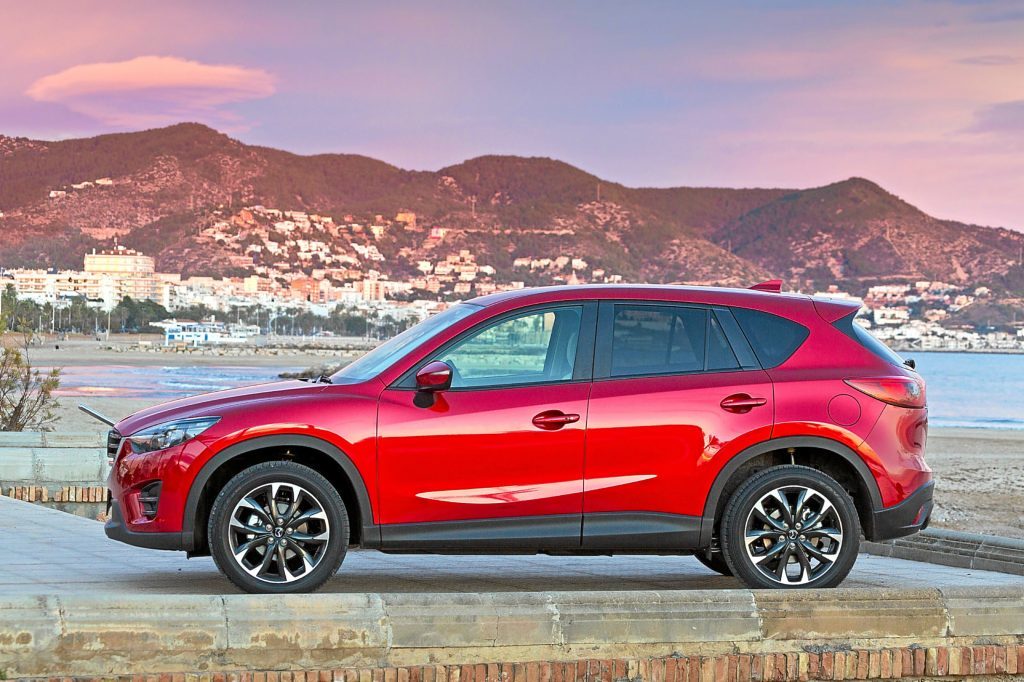If Nissan invented the mass-market crossover with the Qashqai, Mazda drove it forward with the CX-5.
Launched in 2012, it brought in new standards for fuel economy and low CO2 emissions.
Coupled with a handsome exterior, bags of space inside, lots of standard equipment and sporty driving dynamics, it quickly became a common sight on the UK’s roads.
It’s now been given a mid-life refresh.
Changes are fairly minor but there have been useful improvements to items such as the infotainment system, a boost in the quality of the materials used in the cabin and extra features such as piercing LED headlamps.
Buyers have a simple choice of three engines and three specs – SE-L Nav, SE-L Lux Nav and Sport Nav – and all three come with a generous level of equipment as standard.

Buyers have the choice of an entry-level 2.0-litre petrol engine with manual transmission and two-wheel drive.
The better choice, however, is the 2.2-litre diesel.
This comes in 150 or 175bhp strengths, with front or four-wheel drive and a choice of manual or automatic transmissions.
Prices range from around £22,000 to £30,000.
That means for the price of an entry level “premium” compact SUV such as the BMW X1 or Audi Q3 you can have an all-bells-and-whistles CX-5.

My CX-5 was just such a range topper.
The Sport Nav Diesel model had the 175bhp unit, four-wheel drive and a couple of grand of optional extras, including a fantastic £800 “soul red” metallic paintjob that tipped the price from £29,795 to a little more than £31,000.
The diesel unit is excellent: pulling strongly even if the car’s fully loaded.
However, if it were my money I’d shave a bit off the cost and go for the lower powered diesel. It’s only a shade less quick and offers better economy.
My 175bhp model did the 0-62mph sprint in just 8.8 seconds (the 150bhp takes 9.2), making it faster than almost all its major rivals.
Economy is good too, at 54.3mpg – although the cheaper diesel returns 61mpg.
All the power in the world makes little difference if a car doesn’t drive well. Fortunately, that’s not a problem for the CX-5.
It handles with an aplomb that belies its size and height. Ride quality is also first rate and it’s a terrific car on long journeys.
The inside is among the roomiest in its class: rear passengers are well catered for and dogs will have room to sprawl in the boot.
An intuitive rotating bezel makes the infotainment system a cinch to use.
The success of the CX-5 has paid off handsomely for Mazda. The company had been stung by the disaster that was its previous crossover, the CX-7.
Although it had all the right attributes – great looks and drive, a bargain price – the CX-7 was initially launched with a 260bhp, 2.2-litre petrol engine that had terrible fuel economy.
By the time Mazda got round to launching a diesel version, years later, the writing was already on the wall for the CX-7 (although diesel models, which come with a huge spec, are a terrific secondhand buy).
Not only did the CX-5 erase bad memories of a failed model, it put the company back in the black, sold more than 800,000 units, and gave Mazda the confidence to launch the compact CX-3 sister car.
Its success deserves to continue.
Price: £29,795
0-62mph: 8.8 seconds
Top speed: 129mph
Economy: 54.3mpg
CO2 emissions: 136g/km


